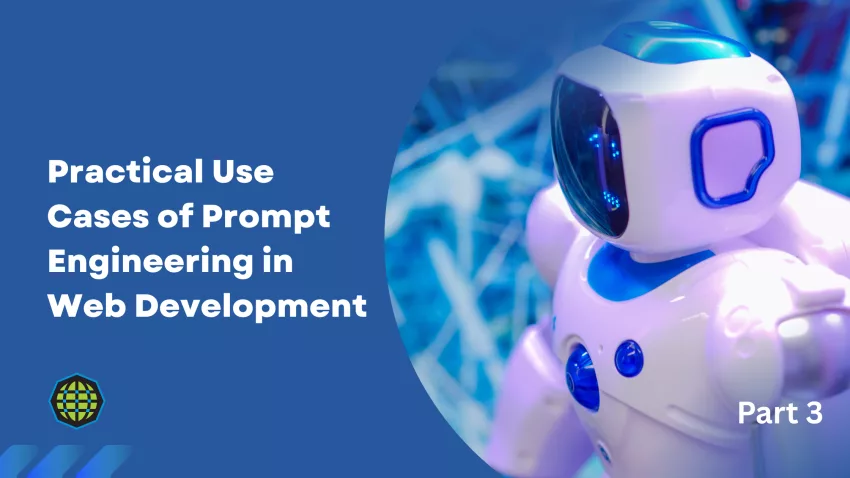Introduction
In the previous parts of this series, we introduced the concept of prompt engineering and discussed why it’s becoming an essential skill for developers. Now, let’s dive into some real-world examples and use cases where prompt engineering can be applied in web development. Whether you’re working with React, Node.js, Laravel, or any modern web development stack, prompt engineering can streamline your workflow, save time, and improve the quality of your code.
In this section, we will cover how prompt engineering can assist with frontend development, backend development, unit testing, debugging, and more. We’ll also provide examples of prompts that you can directly use in your projects.
Frontend Development Use Cases
- Generating Components in React Frontend development often involves creating reusable components. With prompt engineering, you can quickly generate boilerplate code for common components like forms, buttons, or modal dialogs. Example Prompt:
“Generate a React component for a login form with fields for username, password, and a submit button. Ensure the form is responsive using Tailwind CSS.” This prompt will provide you with a full React component and the necessary CSS classes to make the form responsive. - Styling with Tailwind or Bootstrap With prompt engineering, you can have AI suggest styles for your components, helping you quickly set up a UI with frameworks like Tailwind CSS or Bootstrap. Example Prompt:
“Create a responsive card layout using Tailwind CSS. The card should contain an image, title, description, and a ‘Read More’ button.” The AI will generate the HTML structure along with the appropriate Tailwind classes for a fully styled card. - Generating Accessibility Fixes Ensuring accessibility (A11y) is crucial for modern web applications. AI can help generate accessibility improvements for your components. Example Prompt:
“Improve the accessibility of this React button by adding proper ARIA roles and focus states.” The AI can analyze your code and provide suggestions to improve accessibility, such as addingaria-labelattributes or focus styles.
Backend Development Use Cases
- Generating RESTful Routes or Controllers (Node.js, Laravel) Backend development often involves creating RESTful APIs and controllers. With prompt engineering, you can quickly generate API routes and controllers for common use cases. Example Prompt:
“Generate a Node.js controller for handling user authentication with login, registration, and logout routes. Use express.js and JWT for authentication.” This will generate the backend code with route handlers, middleware for authentication, and logic to handle login, registration, and JWT tokens. - Validating Input and Generating Middleware Input validation is a fundamental part of backend development. With AI assistance, you can generate validation logic for user input and form submissions. Example Prompt:
“Write a middleware function for Laravel that validates user input for registration, ensuring the username is unique and the password meets security requirements.” The AI will generate the validation logic, including checks for unique usernames and strong passwords. - Refactoring Backend Code for Performance AI can also help refactor backend code to improve performance or follow best practices. Example Prompt:
“Refactor this Node.js API endpoint for better performance, removing unnecessary database queries and using async/await for asynchronous operations.” The AI will analyze your code, suggest performance improvements, and provide a more efficient solution.
Unit Testing and Documentation
- Generating Unit Tests Testing is crucial to ensure your application works as expected. With prompt engineering, you can quickly generate unit tests for your code. Example Prompt:
“Write Jest tests for this React component. Ensure the tests check for form validation, error messages, and successful submission.” The AI will generate the test cases needed to validate your React component, ensuring the functionality is well-tested. - Creating Technical Documentation Writing documentation can be time-consuming, but with AI, you can generate documentation for your code automatically. Example Prompt:
“Generate API documentation for the following routes in my Node.js app: GET /users, POST /users, DELETE /users/{id}. Include details like request parameters and response examples.” The AI will generate the API documentation in a readable format that you can directly use in your project.
Fullstack Development Scenarios
- Mock API Creation AI can help you generate mock APIs for testing or prototyping. This can be particularly useful when you don’t have access to a real backend yet. Example Prompt:
“Generate a mock REST API for managing tasks with endpoints for creating, updating, and deleting tasks. Use JSON as the response format.” The AI will create a mock API with JSON responses that you can use to simulate backend interactions during development. - Deployment Configurations and CI Pipelines Setting up deployment configurations and continuous integration (CI) pipelines can be a complex task. With prompt engineering, you can quickly generate configurations for various platforms. Example Prompt:
“Generate a CI pipeline configuration for GitHub Actions that runs tests and deploys a Node.js app to Heroku after every push to the main branch.” The AI will provide the configuration for the CI pipeline, automating tests and deployment.
Conclusion
Prompt engineering can significantly enhance your web development workflow by automating repetitive tasks, generating code, and improving the efficiency of debugging and testing. Whether you’re working on frontend or backend development, unit testing, or documentation, prompt engineering has practical applications that save you time and increase productivity. By integrating prompt engineering into your daily workflow, you can accelerate your development process and focus on more critical tasks.
Having learned how to apply prompt engineering to real-world web development tasks, you’re now ready for Part 4! In the next article, we’ll cover best practices for writing effective prompts that can maximize the quality of your AI-generated outputs.
Don’t miss Part 4! We’ll show you how to craft precise prompts that deliver optimal results and enhance your development efficiency.
